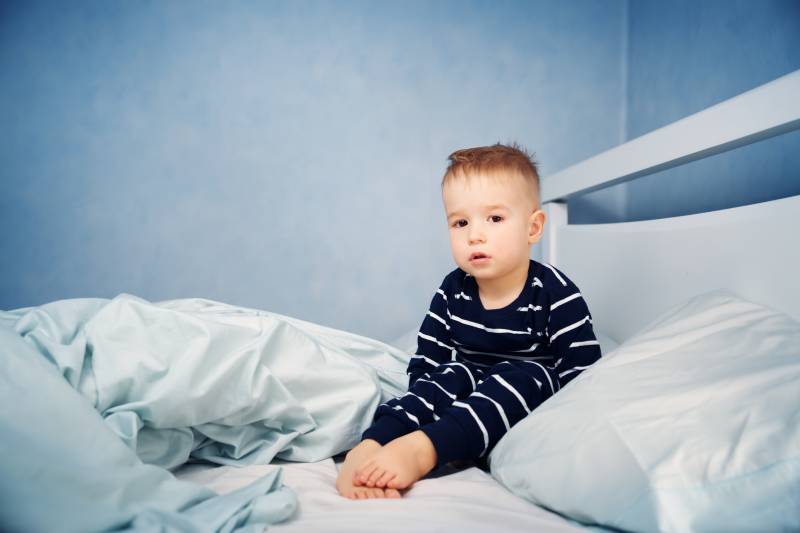Most days, Jen Lamott would describe her daughter, Katie, as cheerful and kind. Lately, though, the 7-year-old has been acting moody and sometimes grunting instead of talking. “It’s like we have a teenager suddenly,” Lamott said. But while teenagers’ attitudes are usually chalked up to puberty, Lamott knows that something else is at play in her house: exhaustion. Since the coronavirus outbreak this spring, Katie has had trouble falling asleep, expressed greater sleep anxiety and started taking naps to compensate for missed sleep, said Lamott, who lives in Ohio. She also said that her 4-year-old, Riley, comes out of his bedroom more often at night, and both children have become clingier. Those challenges may sound familiar to many families right now. In April, after asking more than 300 parents how the pandemic had affected their children’s sleep, pediatrician Craig Canapari wrote in the New York Times that the most common responses were delayed bedtimes, more conflicts around sleep and increased waking up in the middle of the night.
Lynelle Schneeberg, a pediatric sleep psychologist and author of “Become Your Child's Sleep Coach,” told MindShift that family stress, disrupted school routines and decreased physical activity have caused sleep to suffer for people of all ages during coronavirus lockdowns. While she expected some of those challenges to subside as the school year ended, she worried that for preschoolers and elementary schoolers who have needed extra attention at bedtime, the problems would persist into the summer. Schneeberg compared the situation to a family trip during which the children sleep in the same room as their parents. “Kids love that. And when they come home, they don't really want to give that up,” she said. “So COVID has been something like a long hotel visit.” To help parents like Lamott, Schneeberg offered some tips and tricks from years of helping families and children get better sleep.
Sleep crutches and bedtime baskets
In sleep medicine, a “sleep crutch” refers to the actions or objects that help someone fall asleep. Adults, for instance, might prefer one side of the bed or only use a certain type of pillow. For some children, having a parent perform a soothing action, such as singing or rubbing their back can be a sleep crutch. Kids who get the best sleep, though, are the ones whose sleep crutches are not another human, according to Schneeberg. That’s not because of a moral judgment about independent sleep. Schneeberg’s reasoning comes from research that shows that most people wake briefly four to six times per night. “Most people aren't even aware of it. But we wake up and we sort of check that everything's OK. And a child whose parent was there at sleep onset, they wake up and something’s missing. The crutch, so to speak, that they needed is gone,” she explained.
That’s when children start to creep out of their rooms and into their parents’ beds. Schneeberg said the quality of the adult’s sleep also goes down as a result. To help children learn to self-soothe, Schneeberg suggests creating a “bedtime basket.” That’s a bin or basket that is filled with age-appropriate activities that are relaxing and distracting, such as books, puzzles and drawing pads. Kids can use these items after being tucked in, rather than relying on a parent to stay in the room until they drift off.
Using the 5 Bs
Before kids get to the bedtime basket, though, a consistent routine plays a big role in healthy sleep habits. Schneeberg recommends trying the 5 Bs:
- Bite (a bedtime snack)
- Bath/washing up
- Brushing teeth
- Bathroom (a last trip to the loo)
- Books with mom or dad
For the last one, Schneeberg said that parents should set parameters, such as a set number of picture books per night, a certain number of chapters or a specific amount of time. At the end of the allotted reading time, a child may say they are not sleepy yet but that’s what the parent can direct them to their bedtime basket. Then parents can move onto whatever work or downtime they need to do for themselves before sleeping.
Limiting Stalling
Kids get really creative when trying to delay bedtime, said Schneeberg. They might reel parents back in by saying their feet are itchy, the blankets are wrinkly, something is under the bed, something is at the window, they want the door open, they want the door closed, they want the light on, they want the light off, or — the most popular — they’re hungry. When a parent responds to those pleas, it teaches the child that the tactic works and encourages them to continue. “Sometimes, as parents, you do a little bit of the wrong thing with the right intentions,” said Schneeberg. “So we always have to find that little middle ground of a cozy routine, but one that ends when it should and a child who knows how to put themselves to sleep on their own.”


